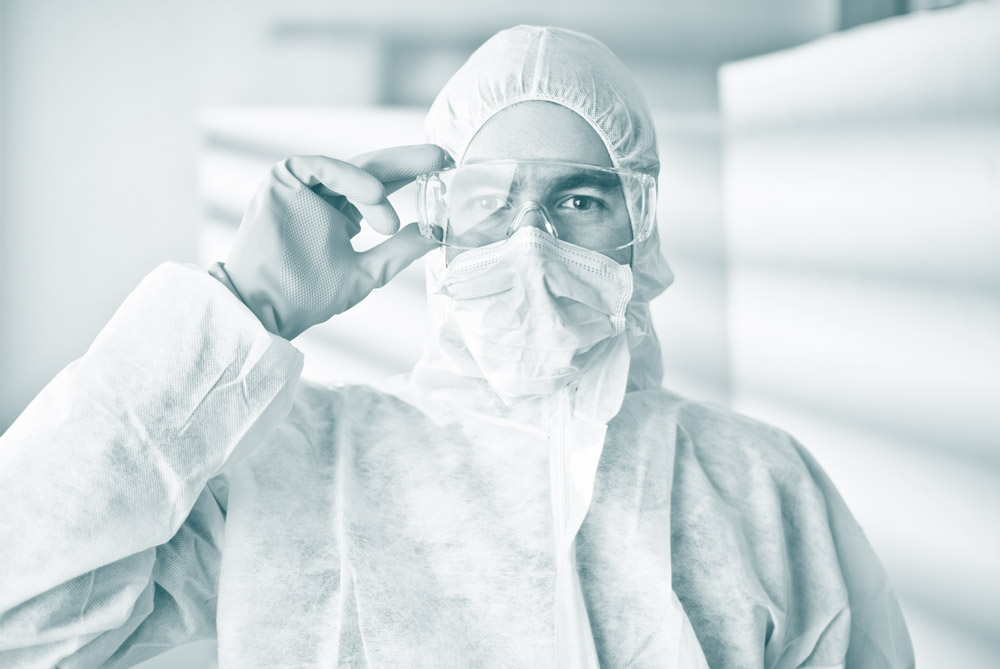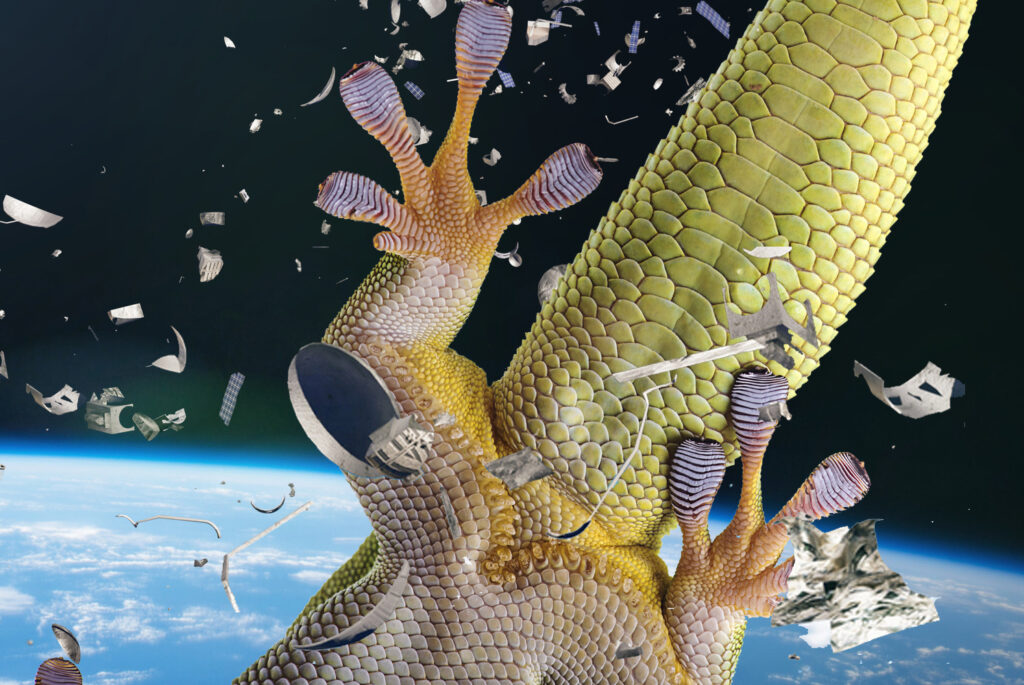Aerospace, Cleanroom News
Gecko Toes in Space
During the course of the last couple of years here at Cleanroom News, we’ve had the opportunity to examine such diverse topics as functional nanomaterials and insect droids, and have been excited to delve into issues that have not only educated but also charmed and fascinated. And perhaps one of the most charming of these was the article we penned on gecko feet. Gecko feet? Well, not literally on gecko feet but about gecko feet. Come now – you remember how we fell down a research rabbit hole of looking into that most beloved of reptilian parthenogens and the way in which micro hairs, known as spatulae, enable gravity-defying adherence – à la Mission Impossible – to walls and ceilings. Just 200 nanometers in diameter, the micro hairs’ superpower is that they leverage van der Waals forces, a type of electro-static adhesion. Van der Waals forces are generated due to an electron’s position within an atom which causes a polarity. The tension between the positive and negative poles of this first atom is replicated by its neighbors resulting in a temporary adhesion between them. In a nutshell, and with apologies to the complex physics upon which these forces rely, this is what’s known as the van der Waals force and is the secret behind the gecko’s superlative climbing abilities. If you would like to revisit the original discussion – or maybe you missed it the first time around? – click on this link to get up to speed. Go ahead – we’ll stick around (see what we did there?) and wait for you to get back…
Did you know, for instance, that both the National Science Foundation and NASA have demonstrated a strong interest in harnessing technology that is based on gecko toes research?
They’re interesting little critters, right? And now that you’re up to date with the basic technology of reptilian feet, hopefully you’ll be hungry to learn more. Because, as of recently, there is a significant amount more to uncover. Did you know, for instance, that both the National Science Foundation and NASA have demonstrated a strong interest in harnessing technology that is based on gecko toes research? According to a fascinating video published by NASA’s Jet Propulsion Laboratory (JPL) in Pasadena, the sticky question about how to make objects adhere in space has, until now, largely been answered by the judicious use of that reliable – but perhaps less than exciting – old stand-by Velcro.(1) But surely, with our arrays of glues and tapes and contact adhesives, we already have the technology to improve upon such a humble and frankly low-tech solution? Well not quite. The problem is that, in the environment of space, traditional adhesion technologies such as glue simply do not work: in the presence of a vacuum, they evaporate so quickly as to boil away before becoming useable. Furthermore, traditionally flexible glues contain volatile compounds which are lost in space, rendering the adhesive brittle and ineffective.
So apart from Velcro and tape which has been used to great effect – recall its life-saving use to repair the carbon dioxide removal system following the crippling of the service module aboard the Apollo 13 mission in 1970 – what other adhesion technologies function in the great vacuum of space?
Van der Waals forces do.
How do we know that? We’re so glad you asked because it gives us the opportunity to highlight trials conducted aboard NASA’s zero gravity aircraft, prosaically nicknamed The Vomit Comet. In experiments onboard this enticingly named craft, researchers were able to use a plate-mounted set of engineered ‘gecko feet’ to grab, grip, and manipulate objects from 10kg (approximately 22lbs) to 100kgs (roughly 220lbs) in zero gravity with seemingly little effort. To see how easy they made it look, check out the NASA Jet Propulsion Lab’s Crazy Engineering video online.
So how is this going to be useful in an extraterrestrial environment? In what ways will such futuristic adhesion be of practical benefit to astronauts? Initially, of course, the issue of efficient equipment repair springs to mind. The ability to capture objects more safely in zero gravity will allow for better, quicker, and more precise servicing and repair of satellites such as the ones we depend on daily for communication and national security. Additionally, organizations like NASA and its partners are excited about the potential for engineering robotic cleaner/repair squads that could, to a certain extent, take the place of human operatives in performing the incredibly dangerous Extra Vehicular Activities (EVAs). Space, after all is an unforgiving place at the best of times and that’s assuming we remain within the relative safety of a craft. By using non-tethered robots that could ‘stick’ to the outside shell of spacecraft and crawl around to affect repairs, perform cleaning tasks, or simply inspect and monitor its condition, the safety of human researchers would be significantly enhanced. Given that any Extra Vehicular Activity is fraught with danger and challenges, from radiation exposure to equipment loss or malfunction, to – albeit unlikely – operator error, alternatives that decrease the number of EVAs performed by humans minimize these dangers while correspondingly maximizing the astronauts’ time for other activities.
And then there’s the question of cleaning up the mess we’ve been leaving in space.
According to an article published in Scientific American, astronomers have been concerned at the problem of space debris since as far back as the 1960s.(2) In the article, a graphic credited to Nature depicts the approximately 20,000 objects in the ‘busy skies’ around our planet. Venturing further out to Low Earth Orbit (LEO) of around 2,000 kilometers, the image illustrates how researchers are tracking almost 16,000 known objects. Journeying further out again, in Medium Earth Orbit (MEO) an additional 1500 uniquely identified pieces of space junk circle the planet at altitudes of between 2000 km and 35,000 km. And furthest from our surface, in a Geostationary Orbit (GEO) of around 35,000 km more than 2900 objects rotate around the planet. Of course not all of these objects are junk, but many are and all have the possibility to interact with random bits of defunct satellites, shards of solar panels, lost equipment, or rocket pieces. And these interactions can be both problematic and financially costly – take, for instance, the case of CryoSat 2.
Circling the Earth at 700 km above the surface, the uncontrolled debris threatened to take out the $162million equipment at unless action was swiftly taken.
In July of last year, mission controllers in the European Space Agency (ESA) realized that an unidentified chunk of space debris had suddenly appeared and was on a direct collision course with CryoSat-2, a LEO satellite that monitors the condition of our planet’s ice. Circling the Earth at 700 km above the surface, the uncontrolled debris threatened to take out the $162million equipment at unless action was swiftly taken. With precise calculations of trajectory made, engineers boosted the satellite to a higher orbit with less than an hour to spare before the debris screamed past at speeds of 4.1km/second.(3)
And to date this protocol is the best prevention we have to avert such potentially catastrophic collisions. Again according to Scientific American, ‘In 2017, commercial companies, military and civil departments and amateurs lofted more than 400 satellites into orbit, over 4 times the yearly average for 2000–2010.’(4) And these are all at risk of damage or loss to interactions with space debris. And that’s a problem because, right now, the best we can do is perform continuous monitoring and adjust orbits in order to side-step incoming projectiles. But what if there was an additional tool we could deploy? What if, instead of simply accepting the problem and dodging collisions we could actively work to clean up the mess we’ve created?
Let’s return to NASA’s JPL in Pasadena, California, to revisit the gecko feet research.
Migrating out of a Stanford project, research conducted by Perception Robotics ‘mimics the [geckos’] method and performance of the adhesive system’ in order to create the Gecko Gripper, an innovative technology that arranges pads of micro hairs in pairs or quads with omni-directional grip.(5) The on/off suction created using around 2lbs of pressure exerted on the micro hairs uses van der Waals forces to generate a significant leap in tool efficiency which, when used in the arena of space debris reclamation, is already both efficient and cost effective. It already sounds promising and when we heard that Precision Robotics had been acquired by OnRobot, experts in plug and play electric grippers for use in manufacturing, we realized the project had entered the next level. Combining OnRobot’s lineage as manufacturers of flexible robot arms to pick and place delicate objects with Precision Robotics’ bio-inspired tactile technology, the Denmark-based company aims to revolutionize the field. We are excited to see what comes next…
But if all of this space travel has you feeling a little queasy and longing to return to our small blue marble of a planet, maybe it’s time to get our feet back on the ground and look at other areas in which this technology might be used. According to NASA, the gecko grip technology is of interest for ‘numerous military and security applications [with the] Defense Advanced Research Projects Agency (DARPA) […] testing gecko-like adhesive for surveillance applications for many years.’(6) But if you are leery of increased governmental surveillance, there are other applications.
As we discussed in ‘The Tentacles of Innovation – Is the Future of Robotics Going Soft?’ in November 2016 there is an industry in which robotics would be supremely useful but to which they are not innately adapted. Perhaps until now. You see, when it comes to states like Georgia and the Carolinas, one commodity that that’s integral to the regional economy and iconic to the culture is the perfectly round, gently fuzzy, lusciously ripe and juicy peach. To date, apart from human pickers and packers, some of the best technology available for this type of work would have been something like the suite of grippers created by ClickSmart, a collaborative robotics pioneer that was recently folded into the business unit of the European HAHN Group. The ClickSmart plate is a mechanism that facilitates the swapping of task-appropriate robotic ‘hands’ – known as end-effectors – with minimal downtime or hold-up on packing lines. The plate is attached to a collaborative robot arm that not only recognizes the type of end-effector (grabber) but also knows how to most efficiently control it. Using vacuum suction, the end-effectors lift and move items with porous, uneven, or irregularly-shaped or -sized surfaces. However, given that the adhesion is created via suction, smooth surfaces would seem to be necessary. Back to gecko tech… With van der Waals forces and other electro-static grippers, non-smooth surfaces are not an issue.
And, regardless of which exact technology is chosen, in an industry where time is of the essence and nature’s ravages can only be mitigated so far, speed of production process is paramount making the value of moving to using this new generation of gripping tools is abundantly evident. By replacing human workers with a fleet of never-tiring robots armed with sensitive and precise end-effectors, the process of packaging delicate objects such as easily bruised fruit leverages the power of automation to increase output significantly. In the fruit packing industry, a short season of just sixteen weeks creates an intense pressure to pick, sort, grade, pack, and ship the produce, and forces workers into a frenetic schedule to harvest and ship within 24 to 48 hours. Whatever can assist in maximizing production within such a tight deadline has to be good, right?
Yes and no. While improving efficiency and line speed is important, there is of course a potential downside of automation: worker displacement. However, as trends in other industries have demonstrated, displacement from traditionally low-skilled jobs does afford the opportunity to re-assign personnel already intimately familiar with the organization to move into higher levels of engagement. ‘Upskilling’ – fully developing an employee’s capabilities and potential – offers the possibility of a win for the employer and for the employee alike. After all, for the corporation, giving an individual greater responsibility allows for enhanced employee retention, corporate growth, and profit; and, for the employee, promotion to more elevated roles usually results in a strengthening of job security, an uptick in salary, and a boost to job satisfaction.
So from fruit pickers and packers in Georgia to satellites in geostationary orbit, the technology engineered from the study of humble gecko toes is little short of astonishing. When we first examined the subject in 2016, we could not have foreseen the degree to which the field would change or the opportunities that would present themselves from the work of governmental researchers at organizations like NASA’s JPL or the National Science Foundation or from corporate ventures such as OnRobot or Rethink Robotics/HAHN Group. In just a couple of years the landscape – spacescape? – of the technology has changed so radically that we are more curious than ever to see where our interest in gecko feet will have us travel. Stay tuned!
Where do you see this technology heading in the next 2 to 5 years? We’d love to hear your thoughts!
References:
- https://www.youtube.com/watch?v=6zasTmmR95E
- https://www.scientificamerican.com/article/the-quest-to-conquer-earths-space-junk-problem
- ibid
- ibid
- http://www.perceptionrobotics.com/gecko-gripper.html
- https://www.nasa.gov/mission_pages/station/research/experiments/2324.html





















HAVE AN IDEA FOR CONTENT?
We are always looking for ideas and topics to write about.
Contact Us